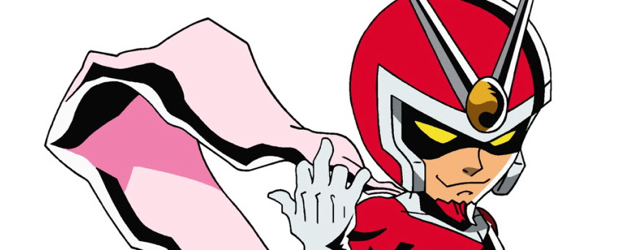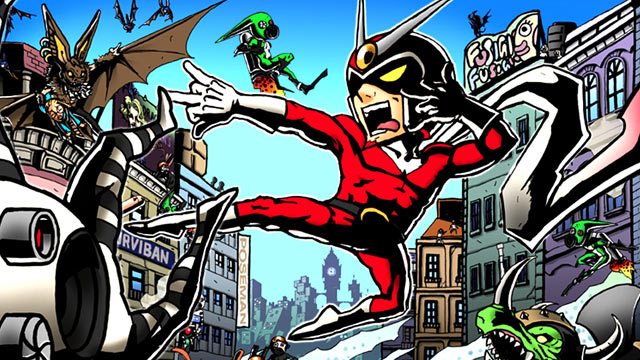
|
There’s something almost ominous about this week’s title that caused me to step back and have a think. “The Others,” it’s very… alien, I suppose. Not only is it the direct opposite to “The Self,” if you listen to my literature professors at least, but there’s an intangible feeling of dread attached to it. And not just because of that creepy film starring Nicole Kidman, either. Saying it out loud just creates this effect of dragging your train of thought out of current place and time and just forces you to think about something, anything disconnected to you. Forgotten. A memory, or perhaps even a ghost.
And that’s what I’m talking about this week: ghosts. And not in the Casper, sheet-over-the-head sense, but more of a half remembered idea that was firmly placed in my mind many years ago by the glossy gaming magazines that I read before the Internet existed for an eight year old. Long before we forgot games on Wii and DS, Capcom launched their vision for an exciting project on the somewhat ill fated Nintendo GameCube. A new wave of alternative video games was revealed as a force within the industry. The Capcom Five was born.

I don’t know why The Capcom Five sticks out so poignantly in my mind as a notable footnote in gaming, but I can distinctly remember the article in CUBE magazine (yes, it was called that) explaining about this ambitious, exclusive project. The vague descriptions of the likes of Killer7, Viewtiful Joe, Dead Phoenix, P.N.O3 and a brand new, exclusive Resident Evil game seemed exciting, thrilling and distinctly foreign to the simplistic yet approachable experiences being offered by Nintendo at that point. More than that, The Capcom Five showed a company that cared about GameCube almost as much as Nintendo. The project was a promise to deliver something truly special to gamers, something against the wave of normality that populated gaming.
Of course, the Capcom Five didn’t turn out exactly as planned. Five became four when Dead Phoenix, a game featuring a fallen angel with more than enough ammunition to shoot heaven out the sky, was canned. Then, three of the surviving quartet ended up becoming multi-platform releases on PlayStation 2 and GameCube. Surprisingly, the initial exclusivity of the games was later revealed to be a communication error and that only Resident Evil 4 would be a guaranteed exclusive to GameCube. (Yes, I seem to remember that not going to plan either!)
But regardless of the shortfalls of the Capcom Five, the cancellations and lack of exclusivity, the disappointing review scores and sales figures, the project had a lasting effect on the gaming industry. These largely forgotten games (yes, even Resident Evil 4) each made an impact on the landscape of gaming in their own way, long before we failed to appreciate the games they went on to inspire.
If you’re unaware of the games that made the Capcom Five, and to be fair it was quite a while ago, then you could well be surprised to find that one of the most successful games out of this line up was a 2D, side scrolling, single player fighter. “Inspirational, really? That sounds rather ’80s and outdated!” I hear you naysayers cry out and to those naysayers I can only say, “Haven’t you ever played Viewitful Joe?”

Marrying an old school gameplay style with a super quirky, incredibly cartoonist, cel-shaded style, Viewtiful Joe not only played a mischievous foil to the serene beauty of Nintendo’s Wind Waker but also made leaps and bounds to help return 2D into the gaming arena. In a time before the advent of HD consoles becoming the norm and somewhat stale in many respects, and in an age when casual, bite-size gaming experiences were unavailable for download, a fully fledged 2D adventure was a big gamble. Luckily, it was one that paid off for the series; and teamed with Joe’s world-bending super powers (Mirror’s Edge bullet time, you are welcome) made for an exciting, amusing, outrageous and challenging experience.
Out of the four original IPs to feature in the Capcom Five, Viewtiful Joe was the one to enjoy the most fruitful lifespan as a franchise. Not only enjoying a direct sequel, the imaginatively titled Viewtiful Joe 2, there was also a DS sequel and a somewhat ignored beat-em-up that drew heavily from the Smash Bros. franchise. Joe’s adventures came to an end when the team behind them, Clover Studio, was dissolved by Capcom and became a part of Platinum Games, but the unlikely hero has lived in on several other Capcom projects, including the highly appreciated Tatsunoko vs. Capcom: Ultimate All Stars.
 While the legacy of Viewtiful Joe is fairly evident to all (I mean, he had his own anime; that’s when you know you’ve made it), some other games from the Capcom Five ended up becoming less prominent in gaming, though still remain as interesting footnotes. Very little was revealed about the Five’s single failed project, Dead Phoenix, though the concept dead seemed to rich in potential. The few screenshots of the game that were released showed a winged character flying freely in vast worlds, which lead many at the time to make connections to Nintendo’s much forgotten Kid Icarus franchise. When Dead Phoenix was finally canceled after an extensive radio silence, some suspected that the game had been taken out of production to allow for a Kid Icarus rebirth, though an eight year gap may have been slightly longer than Pit fans were initially expecting.
While the legacy of Viewtiful Joe is fairly evident to all (I mean, he had his own anime; that’s when you know you’ve made it), some other games from the Capcom Five ended up becoming less prominent in gaming, though still remain as interesting footnotes. Very little was revealed about the Five’s single failed project, Dead Phoenix, though the concept dead seemed to rich in potential. The few screenshots of the game that were released showed a winged character flying freely in vast worlds, which lead many at the time to make connections to Nintendo’s much forgotten Kid Icarus franchise. When Dead Phoenix was finally canceled after an extensive radio silence, some suspected that the game had been taken out of production to allow for a Kid Icarus rebirth, though an eight year gap may have been slightly longer than Pit fans were initially expecting.
Even though another game did manage to get to market, and be the only one of the four released titles to be exclusive to the GameCube, it’s arguable that P.N.03 had even less of an impact on gaming than the unreleased Dead Phoenix. Featuring a cybernetically enhanced heroine called Vanessa Z. Schneider, whose name sounded like an actress from Nickelodeon and face looked like a head on collision between Joanna Dark and Lara Croft, players had to blow up robots with poses of some kind… I’m not entirely sure, to be honest. Regardless, P.N.03, a worrisome low-point in the history of game titling, received mediocre reviews, dismal sales and simply became another failed gaming venture with a forgettable female at the helm. After a decline in empowered women in gaming (thanks Activision!) it appears that P.N.03 did more harm than good for the portrayal of women. After all, when was the last time you saw a Capcom game with a leading lady?
Back on a more positive track, one game from the Capcom Five that definitely made an impact in gaming was none other than Killer7. Not only was the game the first project by eccentric madman Suda 51 to break out of Japan, but the shooter-come-psychological-thriller’s unique visual style and troubling mentality set a new benchmark in intriguing and disturbing gaming. Taking on the role of Harman Smith, a vaguely schizophrenic criminal mastermind, players switched between Smith’s seven physically manifested personalities as they sought to uncover an international conspiracy that threatens to destroy a dystopian and deadly future. Did I mention that health packs were occasionally found in severed heads that started talking? Yeah, this game was utterly bonkers.

Luckily, KAEDE Smith’s unique mental power was extreme stain removal. And yes, this game was odd.
Trippy, bizarre, violent, stylized and maddening, Killer7 unleashed Suda 51’s unique brand of fascinating and maddening game design upon the overly logical Western world and heralded the release of many of his other projects, including Contact and the 2001 PlayStation 2 game Flower, Sun, and Rain on DS, and the infamous No More Heroes franchise on Wii. While Killer7 may have been overly abrasive for some gaming audiences nearly ten years ago, I personally don’t see the problem, as I love blood-stained protagonists as much as the next person, and its release paved the way for some of the most unique and imaginative games of the last decade to enjoy worldwide releases.
Of course, the only game left to mention of the somewhat legendary Capcom Five is none other than Resident Evil 4, one of the most successful and celebrated games of recent years. While I could easily spout another 1,300 words on the legacy that this game has left, from its rejuvenation of the survival horror genre to the rise in supremacy of the third person over-the-shoulder camera that was pioneered by RE4, I think another aspect of the game that has become more and more prominent in the modern age of gaming was its lengthy production process and Capcom’s ability to repackage the game on multiple occasions to earn more from the same experience much in the same way as downloadable content and expansion packs function for many games today.
After a development cycle of nearly seven years and no less than four versions of the game being ultimately scrapped, Resident Evil 4 is a testament to the ability of developers to dedicate themselves to a project and achieve true greatness, regardless of imposed deadlines. The inclusion of initially unused material (the added sections of the game featuring Ada Wong that were added to the subsequent PlayStation 2 and Wii editions of the game) also saw a new trend in gaming where old products could gain new revenue through expanded editions or online DLC.

While their contributions to the world of gaming may not have been initially obvious upon their release, The Capcom Five affected gaming in both subtle and profound ways. The project’s unique take on treating five games as one entity allows us to look back at that time in gaming and see how trends have evolved and diminished since then, leading to questions of gaming and the future on an ever changing industry. While we may not now which games of this generation will set trends and defy expectations quite yet, it’s an interesting thought that a zombie game, a 2D beat-em-up and a maddening, horror shooter ended up being some of the most influential games of a generation.
Will some of “The Others” from this generation prove to be future classics, games that we hold dearly in our memories and shall look back on as important points in gaming history? There’s no fast way of finding out, but with such a vast array of unique and engaging games on Wii and DS, there must be a few buried treasures down below.




 ShareThis
ShareThis








PN03 has a bad reputation, but I actually prefer it to Viewtiful Joe for reasons beyond the butt wiggling. I think a big part of the problem is that people were expecting a modern action game when really it’s more of an arcadey, rhythm-based shmup.
Viewtiful Joe a great game that I had a hard time getting friends to understand and give a shot… too bad their lost. While I think of it that game would be great remade for 3ds.